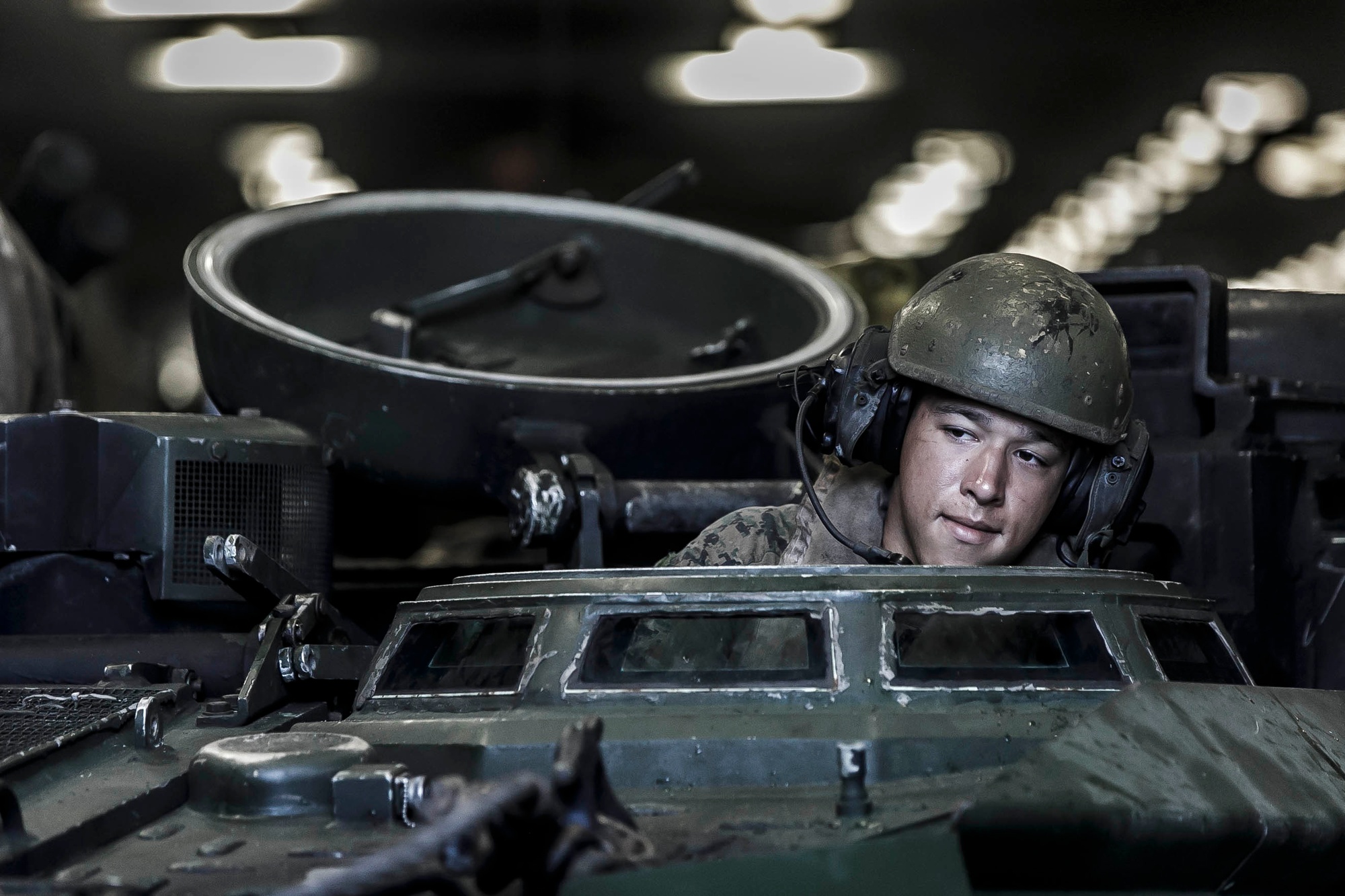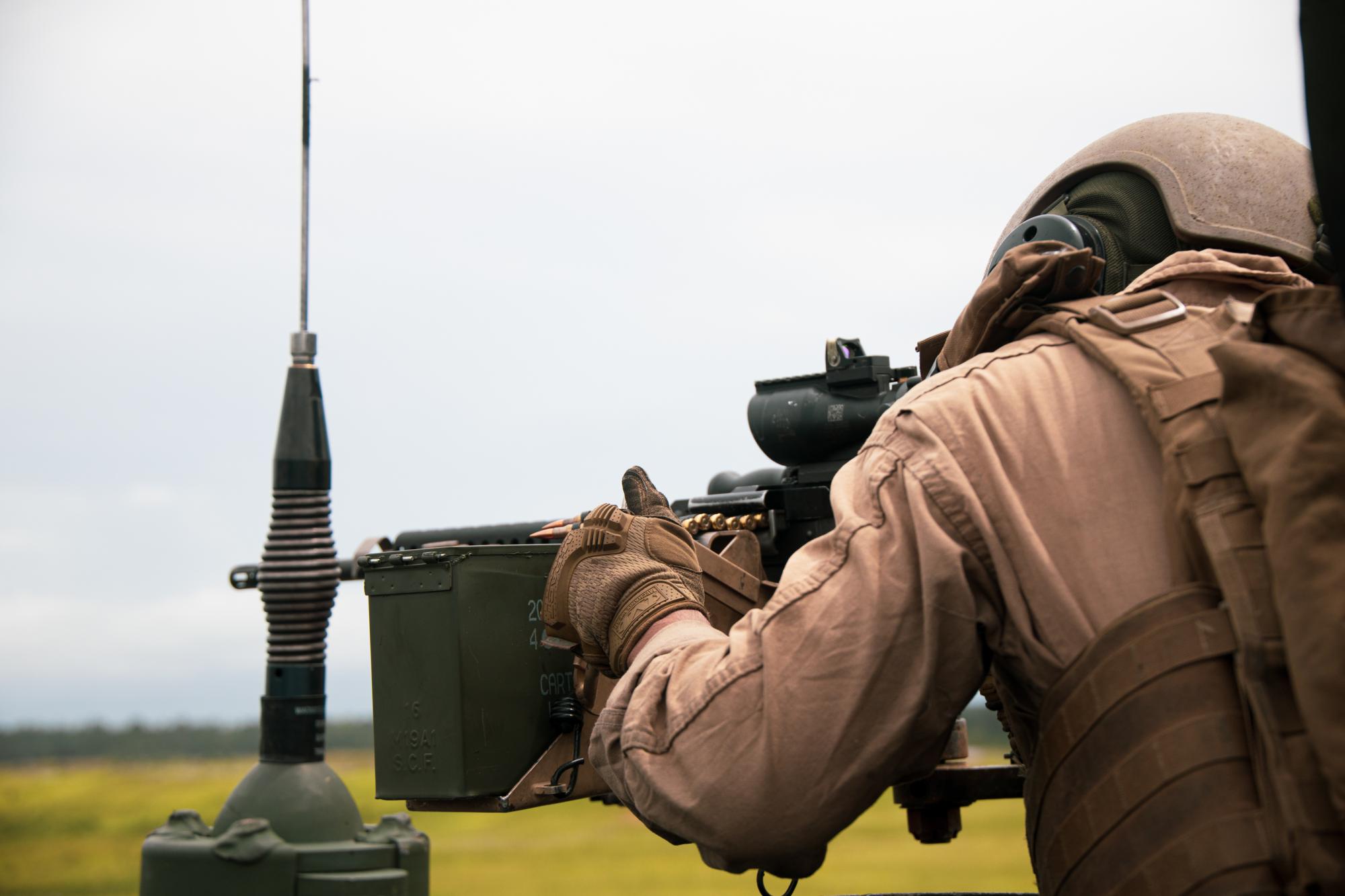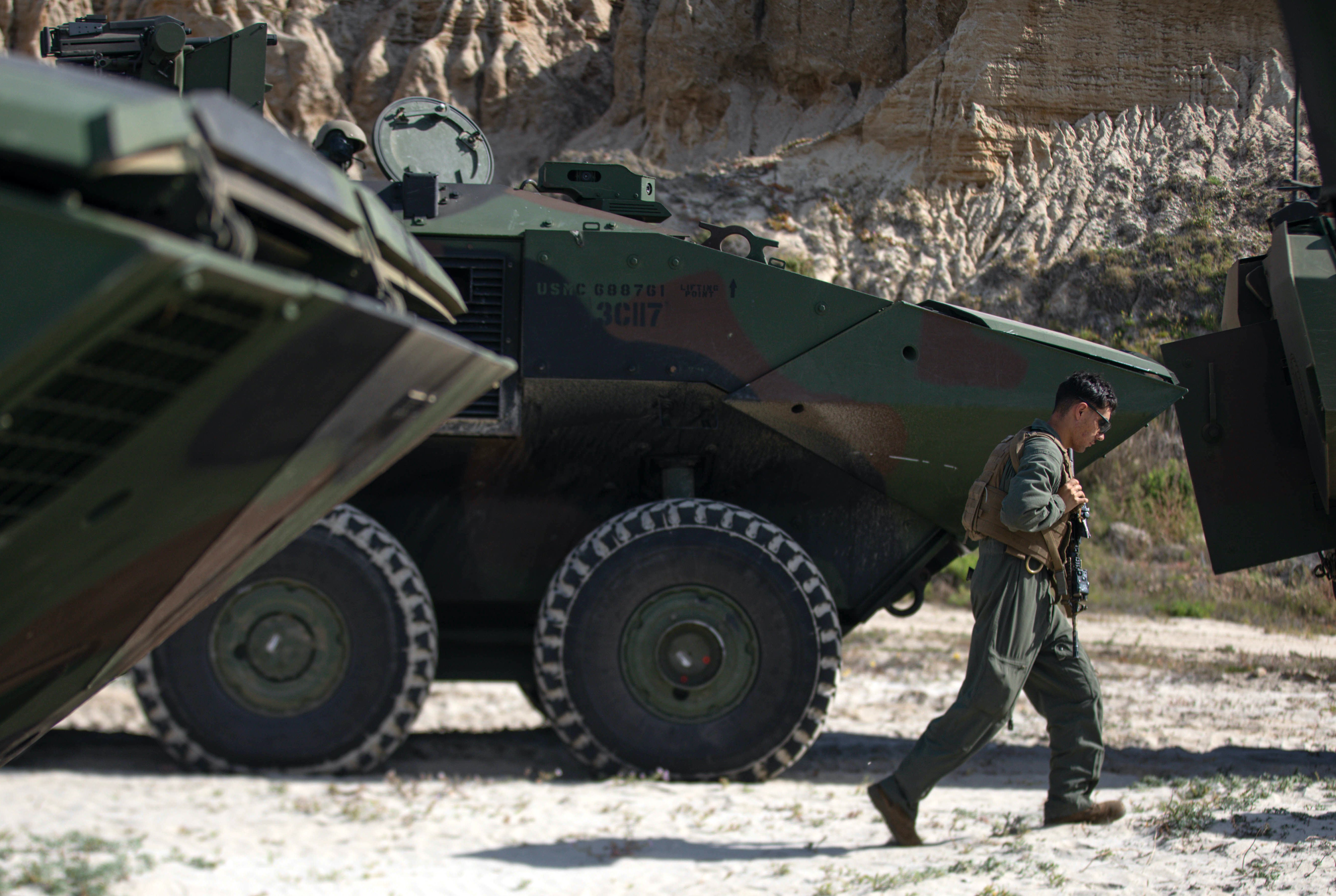Assault Amphibious Vehicle Crewman - Two crossed lines forming an X. Indicates the option to close the communication or opt out of the notification.
Home Chevron Icon Indicates an expandable section or menu, or sometimes previous/next navigation options. Military and Defense
Assault Amphibious Vehicle Crewman

The amphibious assault vehicle can be a tough ride for Marines—the crews have to be prepared to handle it
U.s. Marine Corps Cpl. Alex Evers, An Assault Amphibious Vehicle Crewman, With 3rd Assault Amphibious Battalion, A Native Of Cave Creek, Arizona, Poses For A Photo During An Amphibious Landing Demonstration At
Twitter Icon A bird with a stylized mouth tweeting. Twitter LinkedIn icon The word "in". LinkedIn Fliboard Icon Stylized Letter F. Flipboard Facebook Icon Letter F. Facebook Icon Envelope. Shows the ability to send an email. Email link icon Chain link image. Symbolizes the URL of a website link. copy the link
A US Marine Corps amphibious assault vehicle participating in amphibious operations training. U.S. Marine Corps photo by Lance Cpl. Brian Bolin Jr.
CAMP PENDLETON, Calif. - An amphibious assault vehicle (AAV) is an armored personnel carrier built to transport Marines from ship to shore. These 30 ton crawlers can handle it pretty well, but it can be a rough ride for nearly twenty Marines in the rear.
"It can be difficult," Senior Lt. Nicholas Pierret, in charge of the AAV Live Fire Range, told Insider during a recent visit to Camp Pendleton to check out the latest iteration of the Iron Fist.
File:ditch The Track, Grab Your Rifle, Marines With 2nd Assault Amphibian Battalion Shoot 'modified' Table Four 140902 M Tv331 302.jpg
"Before anyone is loaded into a vehicle, especially on amphibious operations, our team leaders give them a briefing on what to look for in the vehicle and what to do in an emergency," he explained. "It's like the report you get before you leave for a flight, but they say, 'If you need to throw up, don't throw up here.' Throw in your kevlar or whatever you have to do. "
Three-person AAV teams, consisting of a driver, crew chief, and rear crew member, must be prepared not only for vomit, but also for fear, potential rollovers and unexpected failures, and other potential challenges.
U.S. Marines with the 3rd Assault Amphibious Battalion conduct beach landing training with AAV-P7/A1 amphibious assault vehicles during Exercise Iron Fist 2020 at Marine Corps Base Camp Pendleton, California. U.S. Marine Corps photo by Sgt. Desiree Rey

The AAV is the only Marine Corps operational vehicle that can travel both on land and in water. On land, it can race over rough terrain at speeds of up to 45 miles per hour and in water with waves up to 10 feet high.
Remains Of 7 Marines, Sailor Killed In Training Mishap Successfully Recovered
"All the hatches are closed in the back and all you hear is a loud noise and rocking back and forth," said the sergeant. Juan Torres Jr., head of the section, told Insider. "That's why every good crew chief always has a few bags at the track. It's like, 'If you need to throw up, the bags are here.'
Another Marine said the smell can be pretty bad when someone loses their lunch, and it can sometimes make things worse by making others nauseous and starting a chain reaction. "You throw up, you mess up, you clean up," Torres said. "That's my rule."
AAV equipment sometimes lives outside the vehicle, so the last thing anyone wants is to throw up in their AAV.
On January 29, 2020, US Marines with 2nd Battalion, 4th Marine Regiment and 1st Marine Division conduct a mechanized raid at Marine Corps Base Camp Pendleton, California. teagan fredericks
Amphibious Assault Vehicles That Sink Are 'death Traps' For The Troops Inside, Marine Veterans Say After Fatal Accident
The rear crew member, one of three AAV crew members, has several very important jobs in the AAV, and one of them is keeping everyone in line.
"They have to make sure no one is afraid," Torres explained. "I've had quite a few people freak out in the back of Amtrac."
A Marine can be claustrophobic, he said, "and they don't even know they're claustrophobic, and the next thing they know they're going crazy, screaming, 'I need air, I need air.'

Insider learned that such a situation needs to be brought under control quickly as it can negatively affect other Marines, which may cause others to panic unnecessarily.
Reserve Marines Navigate Aav Commander Course
An AAV-P7/A1 amphibious vehicle rolls out of the well deck aboard the amphibious transport ship USS Portland (LPD 27) during U.S. Navy exercise Iron Fist 2020, photo by Communications Specialist 2nd Class Jessica Paulauskas
"One time we splashed in the ocean," Torres told Insider, "and I lost all mechanical functions of the vehicle. I was in the wave zone and we almost flipped over." The AAV had drifted to its side and a large wave nearly overturned the vehicle.
Everything inside the AAV is strapped down for security, everyone except the Marines anyway. There is no seat belt. Marines cling to bench seats and hope for the best.
"However, one of the interesting things about the AAV is that if it flips over, which is really hard to do, it will right itself," explained Pierret.
M Jh495 1002
The Corps' amphibious vehicles are about 40 years old, so it's not uncommon, he explained, for things to go wrong sometimes.
"You can do everything perfectly, and then when you do something, it goes wrong," Torres said. "If everything goes well, you should be worried." Marines explained that most problems tend to be minor, with larger and more serious problems rarely occurring.
One Marine said the hardest part about working with amphibious assault vehicles is not to get frustrated when something goes wrong.
U.S. Marines with the Assault Amphibian School, Training Command, escape from a simulated underwater amphibious vehicle during underwater vehicle egress trainer training in the Area 53 pool at Marine Corps Base Camp Pendleton, California. U.S. Marine Corps photo by Lance Cpl. (Alison Dostie)
Voorhees New Jersey Hi Res Stock Photography And Images
Before any AAV crew member can get hold of an actual AAV, they must first complete underwater survival training. The training vehicle is submerged in a large pool and the AAV teams must open the hatch and escape.
"They put you in different situations, like a slowly sinking vehicle or a rapidly sinking vehicle," he said. "You're on your side or upside down and you've got to get out."
While the training can be unnerving, as one Marine said, the Corps uses a crawl, walk, run approach to make sure Marines are up to the task. Sinking amphibious vehicles are 'death traps' for troops aboard, Navy veterans say after fatal accident
A U.S. Marine communicates with other landing craft as he travels aboard the Australian Navy amphibious assault ship HMAS Canberra during Rim of the Pacific 2016 in the Pacific Ocean, July 18, 2016. (Christopher Giannetti/U.S. Marine Corps)
M Bg142 002
A sinking Marine amphibious vehicle is a "death trap" because of how hard it can be to get everyone out alive, Navy veterans told Insider after a deadly incident this summer.
Several former Marines said the way older AAVs are designed and used make it "difficult" to get a full load of Marines out in a crisis. If it sinks, troops in heavy combat gear must hold their breath and exit the flooded vehicle through narrow, difficult-to-open hatches. Escape plans for the often crowded vehicles seem problematic at best and disaster waiting at worst.
AAVs rarely sink, and mishaps are rare for the 26-ton tracked vehicles, which are made to take Marines ashore under fire from warships at sea, but tragedy struck in late July when the amphibious vehicle quickly sank 385 feet off the coast. During training in Southern California.

The Marine Corps says their AAVs can hold about two dozen soldiers, but it looks like they could reasonably fit about half that. The vehicle that sank in July was quite full and at the time of the accident there were 16 servicemen on board.
U.s. Marine Corps Sgt. Inain Torres, An Assault Amphibious Vehicle Crewman, With 3rd Assault Amphibian Battalion, 1st Marine Division, Poses For A Portrait During A Field Exercise (fex), At Camp Pendleton, Calif.,
Eight Marines and one Navy sailor were killed. Most appear to have never made it out of a sinking vehicle. The incident was the deadliest training accident in the Corps' amphibious assault history.
The tragedy shook the corporation's confidence in its AAVs, and the commander suspended naval operations pending the outcome of the ongoing investigation. The corps also fired the commander of the unit involved in the accident.
"Until the investigation is complete, we will not know whether the causative factors were related to the vehicle, procedures, training, environment, or a combination thereof," the Corps told Insider, declining to comment on whether or not. . you think your AAVs are safe.
It is still unclear what exactly happened to the AAV that sank this summer, but what is clear is that a sinking AAV is dangerous and in some cases deadly.
Assault Amphibious Vehicle Aav Crewman Mos Patch
AAVs, sometimes called "tracks" or "amtracs," make tough trips even when they don't fill with water and sink, current and former Marines told Insider.
Entering through a large rear ramp, the Marines are like sardines in the 26-foot armored vehicle. It's noisy, hard to breathe, smells of exhaust and diesel, and it's not uncommon for infantrymen to throw up from seasickness or panic claustrophobia when the windowless hull
Second degree assault washington state, 2nd degree assault sentence, 2nd degree aggravated assault, 2nd degree assault mn, 2nd degree assault, 2nd degree assault definition, 3rd degree assault washington state, 4th degree assault washington state, 2nd degree felony assault, 4th degree assault washington, what is assault 2nd degree, 2nd degree assault charges
